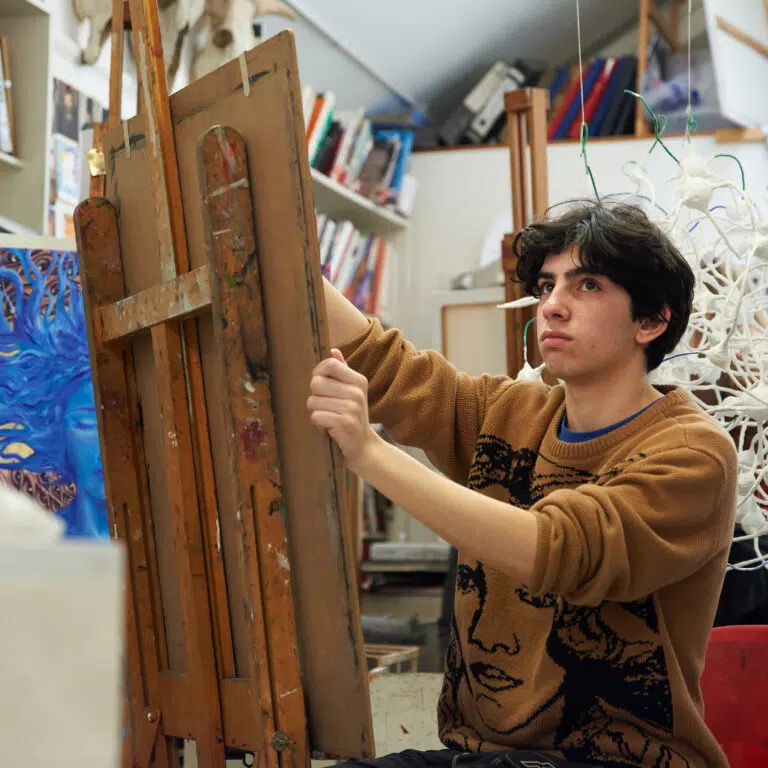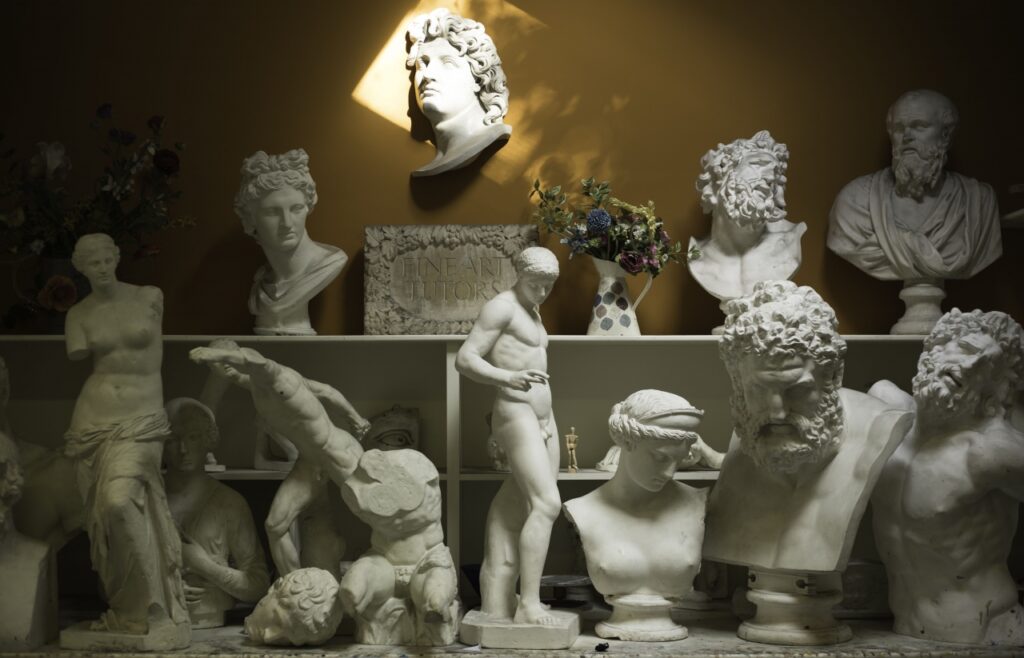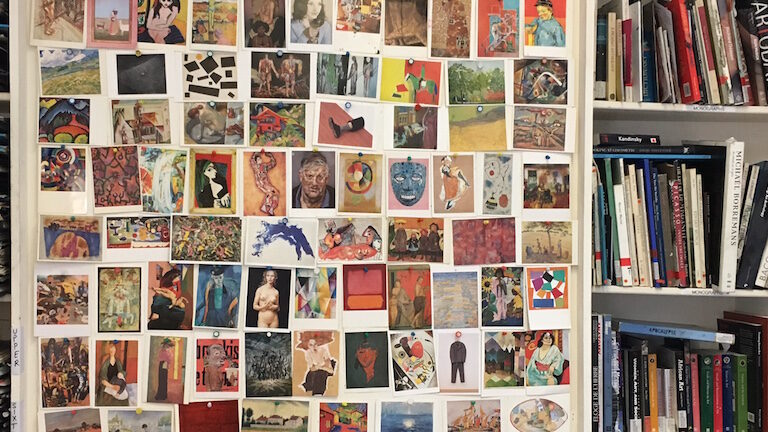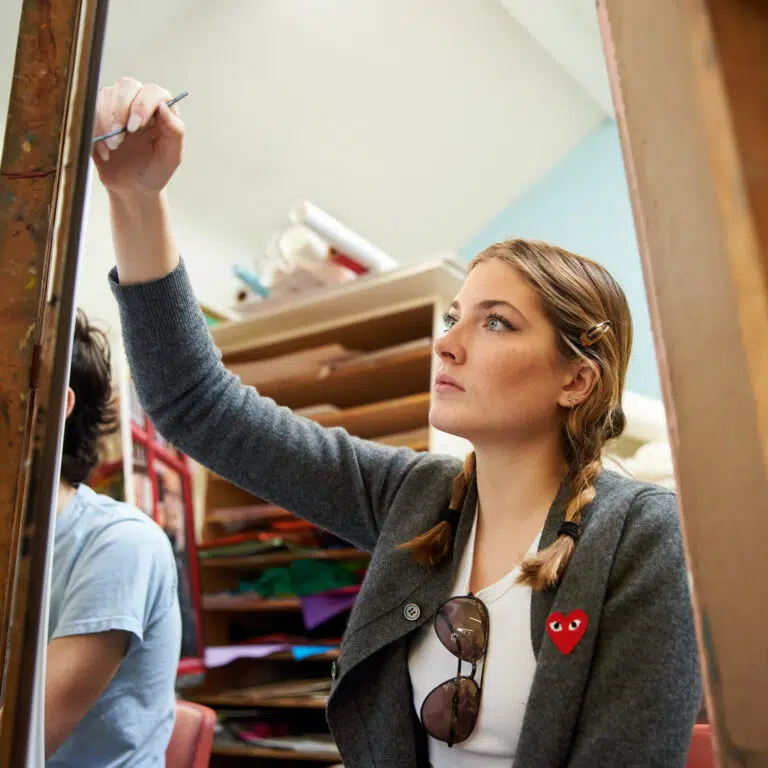Life Drawing and Painting – see here for a look into the student life drawing class.
Fine Art is so much more than merely an aesthetic pursuit – it comprises the demonstration, exploration and scrutiny of contemporary ideas and values through studio practice. Fine Art A level is recognised as being on a par with the most academic A levels because of the emphasis it places on research, conceptual depth and critical rigour. Studying Art at A level gives you the opportunity to express ideas and feelings visually with confidence and facility. Students are able to experiment with a wide range of techniques and media including oil, acrylic, collage and assemblage as well as different drawing and printmaking methods. Students also experiment with time-based media: performance, video and sound work. Concepts and observations are developed and refined in order to communicate clearly and powerfully.
A sound knowledge of drawing is acquired through regular life and still-life classes. The handling of paint and the mixing of colour are taught through painting from observation and imagination. Sketchbooks provide an essential opportunity to explore enthusiasms and interests, and to research and develop ideas through experiments with traditional and contemporary media and processes. Imaginative and self-motivated work is encouraged in order to build a portfolio of coursework. There are regular personal tutorials and assessments. Context and inspiration are provided through the parallel study of the history of art, both classical and contemporary, and through visits to the superb galleries and museums of London, something students are expected to continue in their spare time. Each year there is a study trip to a European city; in recent years we have visited Madrid, Berlin and Vienna.
What will I learn?
The Lower Sixth begins with a foundation term investigating different approaches to the elements of picture-making such as line, tone and colour through a wide range of media and techniques, conventional and unconventional, in sketchbooks, and on a larger scale. Students become accustomed to observational study through oil painting – both still-life and portrait, and to drawing and printmaking methods including drypoint, linocut and monoprint. We engage with different concepts and issues such as the expression of emotion through mark-making and the role of chance in composition.
In the second term we take on a theme, this year the title was ‘The Human Animal’ – here students are able to employ methods and materials of their own choosing. Individuality and originality are crucial and greatly encouraged.
There is a life-painting course in the summer term alongside research to establish a theme for the ‘Personal Investigation’. This is the subject that each student will independently explore for the main A level coursework in the Upper Sixth.
The coursework consists of a sketchbook, a short contextual essay and ‘final pieces’. These pieces may take the form of paintings, sculptures, prints and drawings on an ambitious scale but also increasingly exist in contemporary media like video and performance. Students are encouraged to include psychological, political, philosophical as well as aesthetic research. Individuality and originality are crucial and greatly encouraged.
The course concludes with the Externally Set Assignment: research and development of personal ideas around a theme from a choice of twelve. This includes sketchbook research, coursework and 15 hours of examination time.
ASSESSMENT
Students are given continuous feedback throughout the course on four assessment objectives:
- Developing ideas and critical understanding through contextual sources.
- Exploring a range of materials, techniques and processes.
- Recording ideas and observations and reflecting critically on progress.
- Presenting a meaningful response from your research.
The 15-hour practical examination will take place in the second year as part of the Externally Set Assignment.
Most students will have a GCSE pass (A*-C) in Art and/or Design. It is essential to have a passion for the subject and a willingness to work hard. A personal approach is encouraged throughout the course and it is expected that students will work in their own time to develop their projects independently.
Department successes
Last year a Fine Arts student was among a small number of young artists selected for the Royal Academy Student Summer Exhibition.
Fine Arts College has seen many students progress to leading art colleges both domestic and international. In recent years this has included the Slade, Chelsea College of Art, Edinburgh University, Central Saint Martins, Camberwell, Kingston, City and Guilds, the Instituto Marangoni, and the Parsons School of Design in New York.
Examination Board: Eduqas
“The fine arts approach provides a strong traditional grounding, which leaves many students with strong enough technical skills to bypass foundation courses.”
Good Schools Guide, 20th Edition – Fine Art





